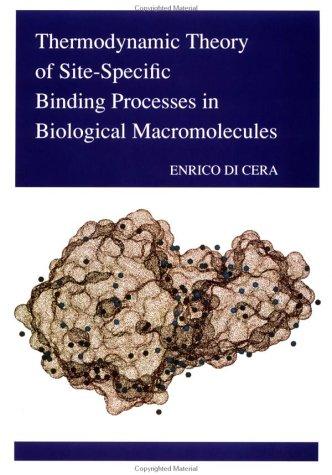Thermodynamic theory of site-specific binding processes in biological macromolecules - Info and Reading Options
By Enrico Di Cera

"Thermodynamic theory of site-specific binding processes in biological macromolecules" was published by Cambridge University Press in 1995 - Cambridge, [Eng.], it has 296 pages and the language of the book is English.
“Thermodynamic theory of site-specific binding processes in biological macromolecules” Metadata:
- Title: ➤ Thermodynamic theory of site-specific binding processes in biological macromolecules
- Author: Enrico Di Cera
- Language: English
- Number of Pages: 296
- Publisher: Cambridge University Press
- Publish Date: 1995
- Publish Location: Cambridge, [Eng.]
“Thermodynamic theory of site-specific binding processes in biological macromolecules” Subjects and Themes:
- Subjects: ➤ Thermodynamics - Binding sites (Biochemistry) - Ligand binding (Biochemistry) - Macromolecules - Cooperative binding (Biochemistry) - Binding Sites - Biochemistry - Protein Binding - Macromolecular Substances - Ligands - Carrier Proteins - Thermodynamik - Makromolekul - Chemische Bindung
Edition Specifications:
- Pagination: xvi, 296 p. :
Edition Identifiers:
- The Open Library ID: OL783257M - OL2913946W
- Online Computer Library Center (OCLC) ID: 501483620 - 32390057
- Library of Congress Control Number (LCCN): 95015257
- ISBN-10: 0521416590
- All ISBNs: 0521416590
AI-generated Review of “Thermodynamic theory of site-specific binding processes in biological macromolecules”:
Snippets and Summary:
We are interested in a system composed of a biological macromolecule and a number of ligands, of which the solvent can be considered one, under conditions of temperature and pressure of biological relevance.
"Thermodynamic theory of site-specific binding processes in biological macromolecules" Description:
The Open Library:
This book provides the first systematic treatment of the thermodynamic theory of site-specific effects in biological macromolecules. It describes the phenomenological and conceptual bases required to allow a mechanistic understanding of these effects from analysis of experimental data. The thermodynamic theory also results in novel experimental strategies that enable the derivation of information on local, site-specific properties of a macromolecular system from analysis of perturbed global properties. The treatment focuses on binding phenomena, but is amenable to extension both conceptually and formally to the analysis of other cooperative processes, such as protein folding and helix-coil transitions. Much attention is devoted to the analysis of mutational perturbations used as probes of site-specific energetics. The arrangement of various sections in the book allows its use both as a reference work on cooperative binding phenomena for any scientist involved in structure-function studies of biological macromolecules, and as a text for graduate students in biochemistry and biophysics.
Read “Thermodynamic theory of site-specific binding processes in biological macromolecules”:
Read “Thermodynamic theory of site-specific binding processes in biological macromolecules” by choosing from the options below.
Search for “Thermodynamic theory of site-specific binding processes in biological macromolecules” downloads:
Visit our Downloads Search page to see if downloads are available.
Find “Thermodynamic theory of site-specific binding processes in biological macromolecules” in Libraries Near You:
Read or borrow “Thermodynamic theory of site-specific binding processes in biological macromolecules” from your local library.
- The WorldCat Libraries Catalog: Find a copy of “Thermodynamic theory of site-specific binding processes in biological macromolecules” at a library near you.
Buy “Thermodynamic theory of site-specific binding processes in biological macromolecules” online:
Shop for “Thermodynamic theory of site-specific binding processes in biological macromolecules” on popular online marketplaces.
- Ebay: New and used books.